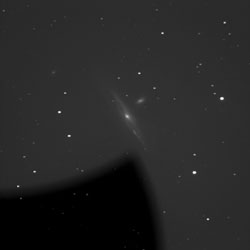Sometimes it is not an electronic problem, but a mechanical one that ends a night of imaging in frustration. Mechanical shutters do have their advantages, they completely block the incoming light making dark frames easy to obtain and allow cleaner readout with some types of CCD's. But like any mechanical part they can fail.
Shutters are designed to open or close in very short time, sometimes in a few milliseconds, this puts a lot of stress on the mechanism with the sudden and very fast movement.
A shutter problem is easy to diagnose, the result is uneven illumination across the field, usually with some clear pattern. A slow or sticky shutter can leave a gradient across the image. If the shutter completely fails all the camera will produce is a dark frame regardless of settings.
Most mechanical shutters make a clear noise when they actuate, keeping an ear out for this noise is often comforting through the night. When it stops you have trouble.
If you are not technically inclined it is best to leave shutter repair to the manufacturer. Some cameras, including many SBIG models, have the shutter in the chamber with the CCD making repair something that should only be done in a suitable facility under clean conditions.

Photo courtesy Steve Peterson.